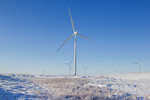How to build a better wind farm
Turbines convert the wind’s kinetic energy into electrical energy as they turn. However, the very act of installing turbines affects our ability to harness the wind’s power. As a turbine engages with the wind, it affects it. One turbine’s extraction of energy from the wind influences the ability of its neighbors to do the same.
“Wind is never going to ‘run dry’ as an energy resource, but our ability to harvest it isn’t infinitely scalable either,” Antonini explained. “When wind turbines are clustered in large groups, their performance is diminished and the rate at which they extract energy is reduced.”
Antonini and Caldeira set out to determine how large a wind farm can be before its generation capability per unit of land reaches the limits of energy replenishment, as well as how much of a “wind shadow” large farms cast, which would have a negative effect on any neighboring downwind installations.
“As we move away from fossil fuels, some scenarios predict wind farms could supply as much as one-third of global energy by 2050,” Caldeira said. “So, it is imperative that we understand the relationship between turbine placement and maximum energy extraction.”
It takes time for the wind to return to normal strength after some of its kinetic energy has been extracted by a wind farm. How quickly wind can recover from encountering a wind turbine is related to the wind farm’s latitude and the Earth’s rotation, Antonini and Caldeira said. Previous studies on wind power generation have noticed wakes behind large wind farms, so Antonini and Caldeira developed a theoretical understanding of the fundamental controls on the size of these wakes.
The size of a large wind farm’s wake is related the speed of the overlying winds, as well as to the amount of time it takes pressure differences in Earth’s atmosphere to replenish the energy that was extracted by the turbines. Antonini and Caldeira’s work indicates that these factors should be considered when determining the size and placement of wind farms under different conditions.
For example, they found that turbines in areas with high winds are more likely to be affected by their upstream neighbors than those in areas with weaker winds. Also, wind farms that are closer to the equator are more likely to be negatively impacted by the wind shadow of upstream wind farms than are wind farms that are closer to the poles.
“Wind energy is a potential source of large amounts of carbon-emission-free energy,” Caldeira said. “But to get the most out of this resource, we need to think about how other wind farms might affect us, and how we might affect other wind farms.”
One idea the authors suggested is that constructing multiple small wind farms with space for wind recovery in between them could potentially be a more effective strategy in some locations than building one massive wind farm, although more research is needed.
“We hope this work will enable the builders and managers of wind turbine installations to design the best possible scenario for maximum wind power generation,” Antonini said.
This work was funded by a gift from Gates Ventures LLC to the Carnegie Institution for Science.
The Carnegie Institution for Science (carnegiescience.edu) is a private, nonprofit organization headquartered in Washington, D.C., with three research divisions on both coasts. Since its founding in 1902, the Carnegie Institution has been a pioneering force in basic scientific research. Carnegie scientists are leaders in the life and environmental sciences, Earth and planetary science, and astronomy and astrophysics.
- Source:
- Carnegie Science
- Author:
- Press Office
- Link:
- carnegiescience.edu/...
- Keywords:
- Carnegie Institution for Science, USA, research, wind farm, size, location, site, turbine, kinetic energy, harness, large, high wind, low wind, speed

























